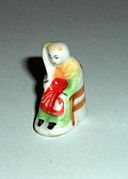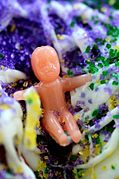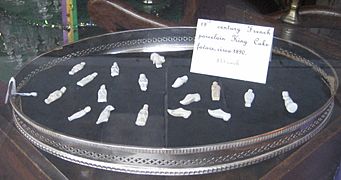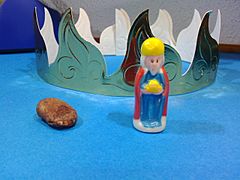Fève facts for kids
A fève (pronounced "fehv") is a tiny surprise hidden inside a special cake, like a king cake. People also call them trinkets or favors. The word fève comes from the French word for 'fava bean'. Long ago, a real fava bean was the original hidden treasure!
Today, fèves can be made from different materials, like porcelain or plastic. They come in all sorts of shapes and sizes. You might find fèves shaped like religious symbols, baking tools, or even famous people. Cakes with fèves are popular across Europe and the United States. They are especially linked to holidays like Three Kings Day or Mardi Gras. The person who finds the fève usually gets special treats or gifts for the day. Fèves have also become popular items for collectors. In France, people who collect fèves are called fabophiles or favophiles.
Fèves in America
In the United States, especially around Mardi Gras in New Orleans and the Gulf Coast, the fève is often found in an American king cake. Here, the fève traditionally looks like a small plastic or porcelain baby. This baby symbolizes baby Jesus. Sometimes, fava beans were also used to represent Jesus.
Finding the baby in your slice of cake is thought to bring good luck and success. The person who finds it also gets the job of buying or baking next year's cake. Or, they might be in charge of throwing the next Mardi Gras party! In some traditions, the finder of the baby is even named "king" or "queen" for the evening.
Because plastic babies replaced beans and porcelain figures, some bakeries now place the baby outside the cake. This lets the customer hide it themselves. Bakers do this to help keep everyone safe. It prevents anyone from accidentally choking on or swallowing the small baby.
Cakes with Fèves
Many different cakes around the world hide fèves inside them. Here are a few examples:
Gallery
-
King and bean from a Spanish rosca de reyes






